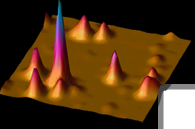Probing Single Molecules with Whispering Gallery Modes of Microspheres

Figure 1: 2-D image (60 microns x 65 microns)
of the emission from a sample of p-terphenyl doped with
terrylene, showing a single terrylene molecule at 1.8K. |
D. J. Norris, M. Kuwata-Gonokami (Univ. of Tokyo), and W. E.
Moerner
One goal of our research effort is to study the quantum nature
of a single molecule and the fascinating "quantum optical" phenomena
which arise. To approach this goal, we have built on previous
single-molecule work which utilized the narrow lines available
from rigid aromatic hydrocarbons at cryogenic temperatures.1 When
embedded as an impurity in a p-terphenyl crystal, molecules such
as pentacene and terrylene exhibit extremely high peak absorption
cross sections, high fluorescent quantum yields, and high photostability
(See Figure 1). These molecules had previously been used to investigate
the basic quantum optics of a single molecule,2 which
indicated that more complicated experiments should be possible.
In particular, we have focused on studying the interaction between
a single molecule and an optical cavity.
Cavity quantum electrodynamics (CQED) predicts that the spontaneous
emission rate of a single molecule can be strongly enhanced if
the molecular transition is in resonance with a small, low-loss,
optical cavity (or microcavity).3 This
enhancement has been observed in atomic beams, in solutions,
and in semiconductors.4-5 Experiments
on a single molecule such as pentacene or terrylene would extend
CQED measurements to a single quantum system embedded in a solid,
in which the molecule is fixed spatially and can be studied for
long periods. For these experiments, spherical microcavities
are particularly convenient resonators. High quality dielectric
(e.g. glass) spheres have optical resonances, or "whispering
gallery modes", which occur when light circulates just inside
the sphere’s surface due to total internal reflection.6
Single-molecule experiments with a dielectric sphere require
not only the detection of a molecule but one which is within
an optical wavelength of the cavity surface and in resonance
with the cavity mode. As demonstrated in Fig. 2, we have satisfied
these requirements by imaging single molecules which are attached
to the surface of a 2mm diameter glass sphere at 1.8K. We have
also shown that by measuring the optical linewidth of the molecule,
one can determine if the molecular emission rate has been modified.
Therefore, our results, the first reported in this area,7 represent
a crucial step toward CQED measurements on a single molecule.
In the relatively large sphere used in our preliminary measurements
for demonstration, no enhancement of the molecular emission rate
has been observed. The project will continue with experiments
on much smaller spheres where modification of the molecular emission
is expected.

Figure 2: Negative microscope image of a p-terphenyl
crystal attached to a 2mm diameter glass sphere (microcavity)
at 1.8K. The black dot in the center is the emission from
a single terrylene molecule which is excited by the optical
resonance of the cavity. |
References
- Single Molecule Optical Detection, Imaging, and Spectroscopy,
edited by T. Basché, W. E. Moerner, M. Orrit, and
U. P. Wild (Verlag-Chemie, Munich, 1996).
- W. E. Moerner, R. M. Dickson, and D. J. Norris, "Single-Molecule
Spectroscopy and Quantum Optics in Solids," Adv. At.
Mol. Opt. Phys. 38, 193 (1997)
- E.M. Purcell, Phys. Rev. 69, 681 (1946).
- S. Haroche and D. Kleppner, Physics Today, January 1989.
- H. Yokoyama, Science 256, 66 (1992).
- Optical Processes in Microcavities, edited by R. K. Chang
and A. J. Campillo, (World Scientific, Singapore, 1996).
- D. J. Norris, M. Kuwata-Gonokami, and W. E. Moerner, "Excitation
of a Single Molecule on the Surface of a Spherical Microcavity," Appl.
Phys. Lett. 71, 297 (1997).
|



